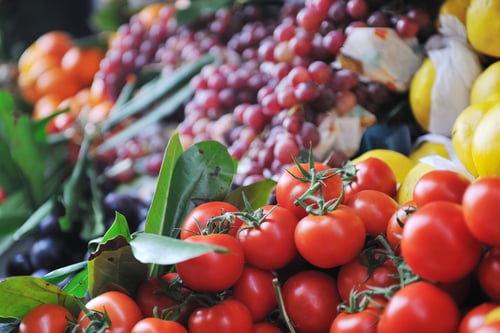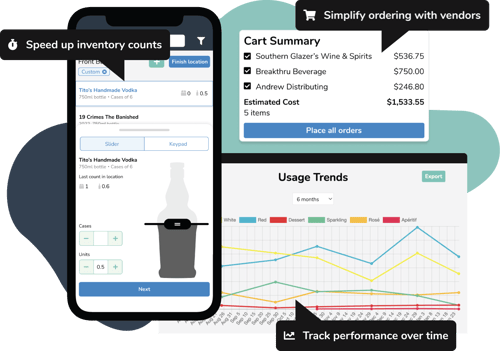If rising costs are hurting your restaurant or bar business, there are ways to fight back. After outlasting a pandemic that turned the hospitality industry on its head, shaking nearly every last coin from its pockets, restaurant operators now face another threat: inflation. Ballooning food and operating costs are compounded by customers with tight wallets who can't—or are hesitant to—spend money on a night out, particularly in the face of rising menu prices. So how can restaurant operators create sustainable revenue to keep their businesses open? We'll explore 4 (and a half!) ways restaurants can fight inflation.
What costs are increasing for restaurants?
Rising food costs are hitting consumers at home and at restaurants
With the national average of gas prices in the U.S. hitting record highs, it's costing more to ship and deliver anything to restaurants. That means price hikes are hitting restaurants from all over.
One area that stands out is the rising cost of food. March 2022 saw wholesale food costs rise by 17% year-over-year. There's no easy way restaurants, especially independent restaurants operating on already tight margins, can absorb a price jump like that.
But by adjusting menu offerings, operators can lighten the blow.
Take a look at the graph below and see what stands out.

1. Add a green touch to your menu
Of course, every category of food has increased in costs. But the cost increase for the meats, poultry, fish, and eggs segment has significantly outpaced all other categories.
The fruits and vegetables segment has had the lowest price increase of all food categories, with current growth at 7.8% according to the U.S. Bureau of Labor Statistics. Price increases for meat have nearly doubled the increase of vegetables with the staggering growth of 14.4% over the same 12-month span.
Offer more vegetarian options and increase plant-based portions
With this in mind, focusing on increasing vegetarian and vegan offerings can lower your cost-of-goods sold for food items and provide higher profit margins for restaurant.
Even just adjusting the portions of meat and vegetables for dishes that include animal-based proteins can reduce costs in order to increase profits.
Highlight vegetable heavy items
 If your business doesn't allow you to go full-on vegan, you can find ways to highlight the veggie-based items you do offer. Utilize menu design to draw attention to your most profitable vegetarian offerings and price these menu items at a price-point that makes them more attractive to customers.
If your business doesn't allow you to go full-on vegan, you can find ways to highlight the veggie-based items you do offer. Utilize menu design to draw attention to your most profitable vegetarian offerings and price these menu items at a price-point that makes them more attractive to customers.
Promote vegetarian-friendly focus
With vegetarian and "flexitarian" diets trending up, especially in urban areas, promoting a plant focus for your restaurant can create new ways to market your restaurant.
2. Focus on alcohol specials and happy hour deals

Rising costs are like pick-pockets, lightening the wallets of customers and cutting their spending powers. When restaurant traffic slows down it's natural to try to attract customers through discounts and daily specials.
Knowing where to apply those discounts is really important. Just like the cost of produce has seen lower inflation rates than meat and poultry, the cost of alcohol has stayed lower than food.
Compared to 17% increase for wholesale food costs, alcoholic beverage costs have only increased by 3.9%, according to the U.S. Bureau of Labor Statistics.
This is good news for full-service restaurants looking to entice customers with pricing discounts. By limiting specials to alcohol you can retain attractive profit margins while promoting drink deals. It also helps that alcohol has the highest profit margin for goods sold by restaurants.
Whether you'd like to promote happy hour specials or offer half-price wine deals, build a promotional strategy focused on alcohol sales.
2 1/2 Reduce Premium Products
Restaurant patrons are cutting back on spending. This will translate into buyers opting for more affordable menu choices. Whether it's spirits, beer, or wine, premium products come with a bigger price tag than well spirits or domestic beers.
If it makes sense for your business and brand, you can temporarily shift to carrying products that are more affordable to the average customer. Bigger brands are able to absorb cost increases better than smaller producers, which means wholesale costs may be more stable, allowing your costs to remain stable, too.
3. Upgrade how you take inventory and purchase products
One of the most important ways to ensure your restaurant or bar is profitable is to streamline inventory management. Understanding your products - from what you have in stock, which products sell or don't, what items turn high profits and which loss leaders bring customers through the door - is the best way to set your business up for success.
Get a better inventory management platform

Improve how you manage inventory by updating the system you use to take counts and analyze inventory performance.
There are a good number of inventory management software options for restaurants, but Backbar is the only free inventory app that allows users to take inventory counts, purchase products from vendors, and review performance insights on what products are profit drivers
Common ways to make inventory improvements
Here's a short list of where many restaurants can improve inventory management.
Consistent Inventory Schedule
Take inventory on a set schedule. Whether that schedule is taking weekly stock counts, bi-weekly, or monthly, will depend on your business. But a set schedule will keep you aware of the products in stock and what you need to order. But more importantly, a consistent inventory schedule gives you vital insights on product usage rates and cost-of-goods sold.
Adjust pricing strategy
Revisit your menu prices and analyze profit margins and liquor cost percentages, especially for high volume sellers. You can improve cash flow with pricing adjustments based on profitability and usage rates to increase high profit sales. Backbar offers a drink price calculator and recipe builder that is great for quickly analyzing pour costs and providing suggested menu prices to boost profits.
Improve order management
Ordering unnecessary products from distributors will cause costs to bloat and saddle a business with overstocked inventory. By paying closer attention to inventory metrics like usage rates you'll know when you need to order items and when you can hold off on spending.
Reduce underperforming inventory
What products are your best sellers? What ones are your worst sellers? If you don't know this, you should. By identifying underperforming products you can focus on either improving sales to reduce stock or stop ordering these items altogether. Reducing inventory stock will cut costs.
Focus on high profit items
The other side of the underperforming coin is high performers. Knowing what products create the most value to your business grows profits by allowing you to increase sales by promoting and improving visibility of high value menu items.
4. Rethink cost percentages in favor of gross profits
A menu is like a map for restaurant guests. A good menu doesn't just list out selections, it guides guests towards making choices that will create a great experience for patrons and generate profits for restaurants.
By taking an engineering approach to your menu layout and prices, you can generate higher levels of profits in order to maintain healthy cash flow during lean times.
Menu engineering as an approach to menu design has multiple components. Like including design elements on a menu that work to highlight certain dishes or cocktails. For example, putting a call-out box around customer favorites or house specials. These design elements guide customers towards choices you want them to make.
But another important element of menu engineering is contribution margin.
The importance of contribution margin is what sets it apart from other menu pricing techniques. A common strategy for arriving at pricing is to base your prices off of a percentage of cost. If a restaurant wants to keep their alcohol costs around 20%, then they could price their items in a way that will achieve that goal.
Here is the formula: (Cost of Item) / (Menu Price) = Cost Percentage.
For example, if you were pricing a Merlot by the glass on your menu, and you want a 20% cost, you'd arrive at your price like this:
| Merlot Glass Cost | Menu Price | Cost % | Contribution Margin |
| $3.20 | $16.00 | 20% | $8.00 |
For many menu items, this might be a fine strategy. But what if your customers aren't willing to spend $16 on a glass of Merlot? They might choose to order a lower priced item.
Maybe they would rather order a Red Blend that is priced at $10. At 20% cost, that means the contribution margin for your Red Blend is $8.00.
| Blend Glass Cost | Menu Price | Cost % | Contribution Margin |
| $2.00 | $10.00 | 20% | $8.00 |
In this scenario, you've met your cost percentage, but you're only generating $8.00 in gross profit per Red Blend sold.
Now, what if you sold your Merlot for $14 instead of $16, and you find that your customers were willing to order more Merlots at $14 instead of $16.
| Merlot Glass Cost | Menu Price | Cost % | Contribution Margin |
| $3.2 | $14.00 | 23% | $10.80 |
This is where contribution margin shows its benefits. Yes, your percentage of cost rose by 3%, but a glass of Merlot is now contributing $10.80 to your gross profit.
By making the glass of Merlot more appealing to your customers, you're convincing them to order more Merlots than Red Blends, and you're adding $2.80 more of gross profit to your restaurant than you otherwise would have.
By prioritizing profit over percentages, you're business will be more stable in the short term because you'll be increasing cash flow.
Key Inflation Fighting Takeaways.
1. Produce costs are rising at a lower rate than meat and poultry. Find ways to include more vegetarian and vegan options into your menu.
2. Offering discounts and special is a common way to attract restaurant customers when traffic is low. When possible, restrict these specials to bar items like wine, beer, and spirits. Alcohol offers the highest profit margins for restaurant goods and alcohol beverage costs rising at about 1/5 the rate of food.
3. Rethink your inventory management strategy. Consistent inventory gives you more insight into product performance that will reduce costs. Try Backbar, the free inventory app to streamline inventory management.
4. Menu engineering guides your guests to order items that are most profitable for you. By prioritizing gross profits generated by menu items over cost percentages, you can tweak menu prices in order to make higher profit margin items more attractive to customers.


